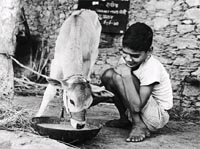Economics melts into religion
 It is a sabbatical for cattle. A few days after the Hindu festival of Raksha Bandhan, just before the harvest of the rabi crop, hal chhatt is observed. Bullocks are rested completely, cows are not milked, and nobody eats anything grown on tilled land for one day. For centuries, Indians have expressed their gratitude towards animals that help them live prosperously, giving the cattle one day off. The occasion is widely observed in India, even today.
It is a sabbatical for cattle. A few days after the Hindu festival of Raksha Bandhan, just before the harvest of the rabi crop, hal chhatt is observed. Bullocks are rested completely, cows are not milked, and nobody eats anything grown on tilled land for one day. For centuries, Indians have expressed their gratitude towards animals that help them live prosperously, giving the cattle one day off. The occasion is widely observed in India, even today.
"In Hindu belief, gobar (cowdung) and gaumutra (cow urine) is considered pure and invaluable. Laxmi, the goddess of prosperity, is said to reside in gobar. The fertility of soil in India has been maintained for millennia by gobar and gaumutra. To me, the most important products from cattle are gobar and gaumutra, and even the most unproductive animals supply these,' says Laxmi Narain Modi, managing trustee of the New Delhi-based non-governmental organisation Bharatiya Cattle Research and Development Foundation. "Their uses vary from medicinal applications, manure for agricultural fields and a cheap and easy way of obtaining fuel in rural India in the form of dung cakes. Cow urine has been shown to light a torch. If this potential is commercially developed, you will have a decentralised source of lighting in every nook and corner of the country.'
M S Randhawa, former vice-president of the Indian Council for Agricultural Research, described an account from the Mughal period to show that Kankrej bullocks could travel 192 km in 24 hours and surpass even swift horses. There are descriptions of cows that gave upwards of 20 litres of milk.
Ashimabha Batobyal, joint commissioner (livestock and poultry), department of animal husbandry and dairying, says that apart from a few pure milch breeds
